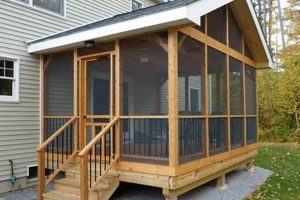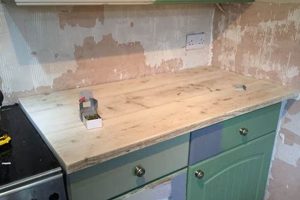The concept refers to creative and resourceful projects involving the repurposing of wooden shipping platforms. These platforms, often discarded after serving their initial purpose, present opportunities for constructing furniture, decorative items, and organizational solutions. Examples include building garden planters, crafting headboards for beds, and designing unique wall art using reclaimed wood.
Utilization of reclaimed wooden platforms offers several advantages, including cost-effectiveness and environmental sustainability. By reusing materials, individuals reduce waste and minimize the demand for new resources. Historically, resourcefulness has been a driver of innovation, leading to the creative adaptation of available materials. Reusing pallets provides a tangible connection to this historical precedent.
The following sections will explore diverse applications of these repurposed platforms, offering practical guidance on selection, preparation, and construction techniques for a range of do-it-yourself projects, with safety considerations emphasized throughout the process. This includes detailed information on sourcing, disassembly, and finishing methods to ensure project longevity and aesthetic appeal.
Essential Considerations for Pallet-Based Projects
Successful implementation of projects using repurposed wooden platforms requires careful attention to several key factors. These guidelines ensure the safety, durability, and aesthetic quality of the finished product.
Tip 1: Sourcing and Selection: Prioritize heat-treated (HT) pallets over those treated with methyl bromide (MB), which is a toxic fumigant. Look for legible markings indicating treatment. Avoid pallets that show signs of significant damage, rot, or staining.
Tip 2: Disassembly Techniques: Employ appropriate tools, such as a reciprocating saw or specialized pallet breaker, for efficient and safe disassembly. Exercise caution to avoid splitting the wood or causing injury. Consider using safety glasses and gloves.
Tip 3: Wood Preparation: Thoroughly clean reclaimed wood using a wire brush and a solution of soap and water. Allow the wood to dry completely before further processing. Sanding removes rough edges and splinters, preparing the surface for finishing.
Tip 4: Design Considerations: Plan project dimensions and structural integrity carefully. Pallet wood may have inherent variations in thickness and width, necessitating adjustments to design plans. Consider using a CAD program for detailed designs.
Tip 5: Fastening Methods: Utilize appropriate fasteners, such as screws or nails, based on the project’s intended use and the thickness of the wood. Pre-drilling pilot holes prevents splitting, ensuring secure and lasting connections. Apply wood glue to joints for added strength.
Tip 6: Finishing and Sealing: Apply a suitable finish to protect the wood from moisture and UV damage. Options include paint, stain, sealant, or varnish. Consider the intended environment and select a finish accordingly. Allow finishes to dry completely before use.
Tip 7: Safety Precautions: Always wear appropriate safety gear, including safety glasses, gloves, and a dust mask, when working with wood. Use power tools responsibly, following manufacturer guidelines. Ensure adequate ventilation when applying finishes.
Adhering to these principles contributes to the creation of aesthetically pleasing, structurally sound, and safe projects from reclaimed wooden platforms. The combination of careful planning, appropriate techniques, and attention to safety leads to successful outcomes.
The subsequent section will address specific project examples, illustrating the practical application of these guidelines and showcasing the versatility of repurposed wooden platforms.
1. Sourcing responsibly
Responsible sourcing forms the bedrock of sustainable and ethical projects involving repurposed wooden platforms. The origin and treatment of these platforms directly impact the environmental footprint and potential health risks associated with their reuse.
- Understanding Pallet Markings
Pallet markings provide crucial information regarding treatment methods and origin. Heat Treatment (HT) is a preferable alternative to Methyl Bromide (MB) fumigation, as MB is a toxic pesticide. Identifying and selecting HT-marked platforms mitigates potential health hazards during the project execution and subsequent use.
- Environmental Impact of Acquisition
Acquiring platforms from local businesses or recycling centers reduces transportation emissions compared to obtaining them from distant sources. Establishing relationships with local suppliers can ensure a consistent supply of appropriately treated and structurally sound platforms, fostering a circular economy.
- Assessing Structural Integrity and Condition
Responsible sourcing includes careful inspection for damage, rot, or contamination. Platforms exhibiting signs of chemical spills or harboring pests should be avoided. Selecting structurally sound platforms reduces the likelihood of project failure and ensures the longevity of the finished product.
- Legal and Ethical Considerations
Obtaining permission before taking platforms from commercial properties is essential. Unauthorized removal constitutes theft. Supporting businesses that responsibly manage their pallet waste streams aligns with ethical sourcing practices, promoting sustainability within the supply chain.
The integration of responsible sourcing principles into do-it-yourself platform projects extends beyond mere material acquisition. It demonstrates a commitment to environmental stewardship, promotes ethical business practices, and ensures the safety and longevity of the resulting creations. Ignoring these considerations undermines the sustainability and integrity of the entire endeavor.
2. Proper preparation
Thorough preparation is a non-negotiable prerequisite for successful projects utilizing repurposed wooden platforms. The quality and longevity of any creation are directly contingent upon the preparatory steps undertaken before construction commences. Neglecting this phase introduces risks ranging from structural instability to compromised aesthetics.
- Disassembly and Component Extraction
Strategic disassembly is paramount. Employing the correct tools, such as reciprocating saws or specialized pallet breakers, minimizes wood splitting and material waste. Careful extraction of nails and staples prevents injury and prepares the wood for further processing. Proper disassembly maximizes the usable material yield.
- Cleaning and Decontamination
Reclaimed platforms are often exposed to environmental contaminants
. Rigorous cleaning with appropriate detergents and disinfectants removes dirt, grime, and potential biological hazards. This process not only enhances hygiene but also improves the wood’s receptivity to finishes and adhesives. Failure to decontaminate can lead to unpleasant odors and health risks. - Sanding and Surface Refinement
Sanding is essential for achieving a smooth and consistent surface. Gradual progression through different grit levels removes imperfections, splinters, and rough edges. This process enhances the tactile qualities of the finished project and ensures a professional appearance. A properly sanded surface also improves adhesion of paints, stains, and sealants.
- Inspection and Material Grading
Before construction, each piece of reclaimed wood must be thoroughly inspected for structural defects, such as cracks, knots, or rot. Grading the wood based on quality and suitability allows for strategic allocation of materials. Higher-quality pieces can be reserved for visible or load-bearing components, while lower-grade pieces can be used for less critical areas.
Collectively, these preparatory actions form the foundation upon which all successful projects utilizing reclaimed wooden platforms are built. Adherence to these protocols ensures structural integrity, aesthetic appeal, and safety. Skipping or abbreviating these steps significantly increases the likelihood of project failure and diminishes the overall value of the finished product. These procedures are fundamental in translating repurposed materials into enduring and functional creations.
3. Design Innovation
Design innovation is a critical catalyst in elevating do-it-yourself projects utilizing repurposed wooden platforms from mere functional objects to expressions of creativity and individualized style. It encompasses the application of novel approaches and imaginative solutions to overcome material constraints and optimize functionality.
- Adaptive Reconfiguration of Existing Forms
This involves reimagining the inherent structure of wooden platforms to serve new purposes. Examples include transforming a standard pallet into a vertical garden by strategically adding planting containers or disassembling it to create modular shelving units. Such adaptations maximize material usage while minimizing waste, showcasing resourcefulness and ingenuity.
- Integration of Multifunctional Elements
Design innovation encourages the incorporation of multiple functions into a single piece of furniture or decor. A platform-based coffee table could integrate storage drawers or a built-in magazine rack. These designs not only enhance practicality but also contribute to space efficiency and a streamlined aesthetic, effectively combining utility with visual appeal.
- Aesthetic Enhancement Through Surface Treatments
Surface treatments play a significant role in transforming the appearance of repurposed platforms. The application of paint, stains, or intricate patterns can significantly alter the wood’s character, aligning it with diverse design styles. Techniques such as distressing, whitewashing, or the incorporation of geometric designs add visual interest, demonstrating the transformative power of aesthetic refinement.
- Sustainable Material Combinations
Design innovation extends to the integration of other sustainable materials alongside the repurposed wood. Combining platform wood with reclaimed metal, recycled glass, or eco-friendly fabrics creates a cohesive and environmentally conscious design aesthetic. These material combinations not only enhance the visual appeal but also reinforce the commitment to sustainability and responsible resource utilization, thereby enhancing the value and appeal of the final product.
The integration of design innovation in projects centered on repurposed wooden platforms elevates the possibilities beyond conventional limitations. By embracing creative adaptation, multifunctional integration, aesthetic enhancement, and sustainable material combinations, these projects transcend mere functionality to become unique expressions of design ingenuity and environmental consciousness, resulting in the transformation of discarded materials into valuable and aesthetically pleasing creations.
4. Structural Integrity
Projects involving repurposed wooden platforms inherently necessitate careful consideration of structural integrity. The strength and stability of the original shipping platform are not always guaranteed, and the process of disassembly, modification, and reassembly can further compromise its load-bearing capacity. Therefore, understanding and addressing structural concerns is paramount for ensuring the safety and longevity of any construction utilizing these materials. Failure to do so can result in collapse, instability, or premature deterioration of the finished product.
The choice of platforms, the techniques used for joining wood, and the overall design all directly impact structural soundness. For example, using platforms with visible signs of damage, such as rot or splitting, presents a significant risk. Similarly, employing inadequate fasteners or failing to properly distribute weight across the structure can lead to eventual failure. Real-world examples include benches collapsing under weight, shelving units buckling, or bed frames unable to support a mattress and occupants. Furthermore, modifications such as cutting large sections of wood without reinforcing the remaining structure can weaken the entire assembly. Conversely, projects employing robust joining methods, reinforcing braces, and designs that strategically distribute weight are far more likely to maintain their structural integrity over time. This understanding has practical significance, guiding builders towards material selection, design choices, and construction techniques that prioritize safety and durability.
In summary, achieving structural integrity in do-it-yourself projects using reclaimed wooden platforms demands a comprehensive understanding of material properties, design principles, and appropriate construction techniques. While the concept offers an environmentally conscious and cost-effective approach to creating furniture and other items, it requires strict attention to detail to mitigate potential safety risks and ensure long-term reliability. Recognizing these challenges and implementing appropriate solutions are crucial for realizing the full potential of pallet-based constructions.
5. Finishing techniques
Finishing techniques are intrinsically linked to the success and longevity of do-it-yourself projects involving reclaimed wooden platforms. The application of appropriate surface treatments directly impacts the aesthetic appeal, durability, and overall utility of the finished product. Without proper finishing, even the most meticulously constructed project can be vulnerable to environmental damage, wear and tear, and aesthetic degradation.
The choice of finishing technique should align with the intended use and environment of the creation. For outdoor furniture, weather-resis
tant sealants and paints are essential to protect against moisture, UV radiation, and temperature fluctuations. Interior projects may benefit from varnishes, stains, or waxes that enhance the wood grain and provide a durable, easily cleaned surface. The absence of such protective measures can lead to premature decay, warping, and discoloration, ultimately reducing the lifespan of the repurposed platform construction. Real-world examples include outdoor benches left untreated that quickly become unusable due to rot, or interior tables that stain easily and become aesthetically unappealing.
Furthermore, the proper application of finishing techniques contributes significantly to the overall aesthetic appeal of projects using reclaimed wooden platforms. Sanding, staining, painting, and sealing can transform rough, weathered wood into a visually appealing surface that complements various design styles. Conversely, neglecting this aspect can result in a project that appears unfinished, unprofessional, or visually jarring. The careful selection and execution of finishing techniques, therefore, represent a critical component in elevating repurposed wooden platform projects from mere functional objects to items of aesthetic value. This detailed execution underscores the importance of proper completion techniques in the context of do-it-yourself undertakings.
6. Safety protocols
Execution of projects based on repurposed wooden shipping platforms necessitates strict adherence to defined safety protocols. The materials involved often possess inherent risks, including splinters, unseen fasteners, and potential chemical treatments. Disregard for established safety guidelines directly elevates the likelihood of injury and compromises the structural integrity of the resulting construction. For example, failure to wear protective eyewear during disassembly may result in eye injuries from flying debris, while neglecting to use appropriate respiratory protection during sanding can lead to inhalation of hazardous wood dust. Therefore, the integration of comprehensive safety protocols is an indispensable component of any undertaking.
Specific safety measures include thorough inspection of platforms for embedded nails or staples, utilization of appropriate personal protective equipment (PPE) such as gloves, safety glasses, and respirators, and adherence to safe operating procedures for power tools. Furthermore, adequate ventilation is crucial when applying finishes or adhesives, mitigating the risk of exposure to harmful fumes. Prioritizing safe practices is not merely a precautionary measure but a fundamental requirement for ethical and responsible material reuse. Real-world consequences of neglecting these protocols range from minor cuts and abrasions to severe injuries and potential long-term health complications. Therefore, understanding the correlation between adherence to safety protocols and project success is vital.
In summary, the inherent characteristics of reclaimed wooden platforms necessitate a rigorous commitment to safety protocols. Neglecting these safeguards poses significant risks, while diligent implementation ensures a safer working environment and contributes to the creation of durable, functional, and aesthetically pleasing outcomes. The principles of safety are not merely supplementary considerations but are fundamental building blocks within the context of do-it-yourself construction, promoting both personal well-being and the responsible utilization of reclaimed materials.
7. Functional Application
Functional application represents the culmination of effort within the realm of do-it-yourself projects involving repurposed wooden platforms. It signifies the successful transformation of raw materials into objects serving a defined purpose, thereby validating the design, construction, and finishing processes.
- Ergonomic Considerations in Furniture Design
Within the scope of furniture construction, functional application necessitates the incorporation of ergonomic principles. This entails designing chairs, tables, and other furniture pieces that accommodate human dimensions and promote comfortable use. For example, a poorly designed chair constructed from reclaimed wooden platforms may lack adequate back support or possess an uncomfortable seat height, rendering it functionally inadequate despite its aesthetic appeal. The absence of ergonomic considerations undermines the utility of the creation, highlighting the importance of anthropometric data in design.
- Load-Bearing Capacity in Structural Elements
In the creation of structural elements, such as shelving units or bed frames, functional application demands meticulous attention to load-bearing capacity. These constructions must be capable of supporting the intended weight without compromising structural integrity. For instance, a shelving unit constructed from inadequately reinforced wooden platforms may collapse under the weight of books or other items, thereby failing its intended purpose. Thorough calculations and robust construction techniques are essential to ensure that structural elements meet the required load-bearing standards.
- Weather Resistance in Outdoor Applications
Functional application in outdoor projects mandates the selection of materials and finishing techniques that provide adequate weather resistance. Constructions such as garden planters or outdoor furniture must withstand exposure to moisture, sunlight, and temperature fluctuations without deteriorating. A planter constructed from untreated wooden platforms may quickly rot or warp, compromising its ability to contain soil and support plant growth. The implementation of appropriate sealants and protective coatings is critical for ensuring the longevity and functionality of outdoor creations.
- Adaptability and Versatility in Design
Functional application can be enhanced through designs that promote adaptability and versatility. Projects that can serve multiple purposes or be easily reconfigured demonstrate a higher degree of functional utility. For instance, a platform-based coffee table with integrated storage compartments offers both a surface for placing items and a space for concealing clutter. The incorporation of modular elements or adjustable components can further enhance the adaptability of these constructions, expanding their potential applications and increasing their overall value.
Collectively, these considerations underscore the integral role of functional application in do-it-yourself projects utilizing repurposed wooden platforms. By prioritizing ergonomic design, structural integrity, weather resistance, and adaptability, creators can transform discarded materials into objects that are not only aesthetically pleasing but also serve a defined purpose effectively, enriching their practicality and overall worth.
Frequently Asked Questions
This section addresses common inquiries and misconceptions surrounding the utilization of reclaimed wooden platforms for do-it-yourself projects, providing clear and concise information to facilitate informed decision-making.
Question 1: Are all wooden platforms safe for repurposing?
No. Platforms treated with Methyl Bromide (MB) are hazardous and should not be used. Platforms marked “HT” (Heat Treated) are a safer alternative.
Question 2: How should
a platform be prepared for use in a project?
Preparation includes thorough cleaning with soap and water, removal of any protruding nails or staples, and sanding to create a smooth surface. Allow the wood to dry completely before further processing.
Question 3: What type of finish is appropriate for outdoor projects?
Exterior-grade paints, stains, and sealants designed to withstand moisture and UV exposure are recommended for outdoor applications. Regular reapplication may be necessary to maintain protection.
Question 4: How can structural integrity be ensured in platform-based constructions?
Employ robust joining methods, reinforce load-bearing areas with additional supports, and carefully consider weight distribution during the design process. The strength of the original platform should also be assessed.
Question 5: Where can wooden platforms be responsibly sourced?
Local businesses, recycling centers, and online marketplaces are potential sources. Always obtain permission before taking platforms from commercial properties.
Question 6: Is specialized equipment required for platform disassembly?
While not always essential, tools such as reciprocating saws, pallet breakers, and pry bars can significantly simplify the disassembly process. Safety glasses and gloves are strongly advised.
The selection, preparation, and construction techniques are crucial to ensure the longevity and safety of platform-based projects.
The subsequent section will offer additional resources and guidance for those interested in further exploring the creative possibilities of repurposed wooden platforms.
Conclusion
The exploration of creative and resourceful projects centered on the repurposing of wooden shipping platforms underscores the versatility and potential of this often-overlooked material. From furniture construction to decorative arts, the applications are diverse, offering both practical solutions and avenues for artistic expression. However, responsible sourcing, thorough preparation, and unwavering adherence to safety protocols are paramount to achieving successful and sustainable outcomes. Ignoring these foundational principles undermines the integrity of the undertaking and introduces potential risks.
The transformation of discarded shipping platforms into valuable and functional objects represents a tangible contribution to environmental sustainability and resource conservation. The continued exploration of innovative design solutions and responsible construction practices will further unlock the potential of this readily available material, promoting a more circular and environmentally conscious approach to creation and consumption. Embracing these principles will ensure that future endeavors not only yield aesthetically pleasing results but also contribute to a more sustainable future.


![Creative DIY Mobile Home Skirting Ideas [Guide] The DIY Hub: Creative Crafts, Repairs & Life Hacks Creative DIY Mobile Home Skirting Ideas [Guide] | The DIY Hub: Creative Crafts, Repairs & Life Hacks](https://craftingdiycenter.com/wp-content/uploads/2025/07/th-4605-300x200.jpg)




